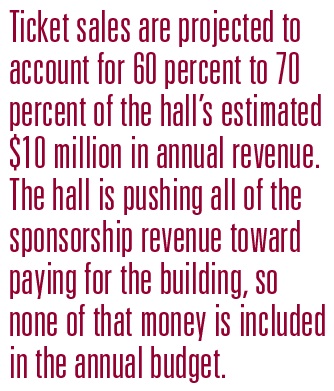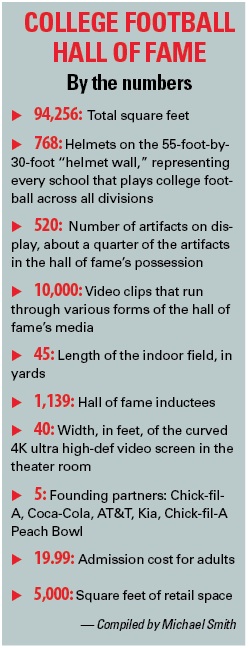John Stephenson’s day on this humid August morning started much like every other day, with Stephenson standing in front of a group of well-heeled Atlanta executives explaining why they should visit the new College Football Hall of Fame.
The questions that came back from this group of Duke alums at the Buckhead Club ran the gamut. Some wanted to know if the hall could make money — halls of fame are notoriously bad businesses. Others asked how many Blue Devils are in the College Football Hall of Fame.
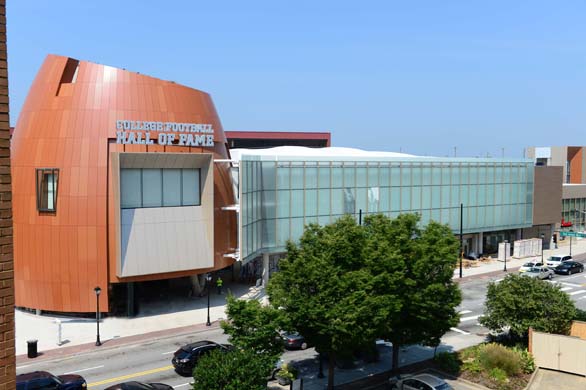 |
The $68.5 million project opens this Saturday in Atlanta.
Photo by: Byron Small |
Stephenson is happy to detail the business model. He doesn’t have the first clue how many Dukies are in the hall.
“People tell me all the time how lucky I am to work in college football,” Stephenson, the hall’s CEO and president, said with a smile. “What I’ve been doing the last 2 1/2 years literally has nothing to do with college football. I’m trying to get a building built.”
Stephenson is almost able to see the final results on Marietta Street in downtown Atlanta, just across from Centennial Olympic Park, the Georgia Aquarium and the World of Coca-Cola.
The college hall spent the past 17 years in South Bend, Ind., but the National Football Foundation, which owns the rights to the hall, decided four years ago to accept an offer from Atlanta organizers. That group, led by Chick-fil-A Peach Bowl President Gary Stokan and Chick-fil-A President Dan Cathy, helped secure the commitment, providing the NFF with a greater platform for its hall and more visibility for the foundation’s scholarship and charitable causes.
Stephenson, formerly an attorney for Atlanta firm Troutman Sanders and a native of the city, took the baton in 2012.
The new $68.5 million building will open on Saturday — on schedule and on budget.
He’s especially proud that only $1 million of public money was used. The rest of the building’s cost has been raised through sponsorship dollars and private donations.
“That’s unusual for an attraction like this,” he said, having already ditched the tie from his morning speaking engagement in favor of an open-collar blue shirt and navy jacket.
The hall is down to its last two major pieces of sponsorship inventory, and when those are sold, the attraction will have the commitments it needs to pay off the 94,256-square-foot building.
Now all the hall needs to do is get people inside of it.
Wow factor
Visitors entering the College Football Hall of Fame will encounter a wall of helmets that’s visually overwhelming. The eyes don’t know where to focus. A touch-screen board enables visitors to find a school, touch an image and light up the helmet.
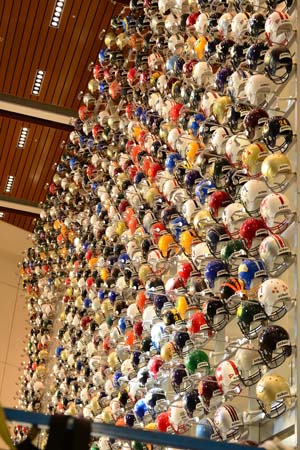 |
Visitors are greeted by a massive wall of helmets from every college football program.
Photo by: Byron Small |
The 768 helmets on the 55-foot-by-30-foot wall represent every school that plays college football, no matter the division. It’s an equal-opportunity display, with the helmets hung randomly. A handful of helmets are generics, placeholders waiting for the next college to start a team.
The hall has worked with helmet-maker Schutt to secure all of the helmets. Two hardworking interns had the chore of putting decals on the side of the helmets.
There’s little question that the wall delivers the wow factor that any attraction hopes for.
“This breaks the mold for sports halls of fame,” said Patrick Gallagher, president and founder of Gallagher & Associates, the Washington, D.C.-based firm that serves as the exhibition designer. Gallagher’s work can be found in any number of museums and exhibits, from the Baseball Hall of Fame to the University of North Carolina’s basketball museum.
The College Football Hall of Fame projects 500,000 visitors a year, an ambitious number compared to the halls for other sports, where 200,000 to 300,000 a year is the norm.
Stephenson looks across Marietta Street and sees more than 2 million people a year visiting the Georgia Aquarium and more than 1 million going to the World of Coca-Cola, so he believes his goal is within reach. The College Football Hall of Fame is right in the middle of all that traffic and the building is literally attached to the Georgia World Congress Center, meaning fans could walk indoors from the hall to the Georgia Dome.
Ticket sales are projected to account for 60 percent to 70 percent of the hall’s estimated $10 million in annual
revenue. The hall is pushing all of the sponsorship revenue toward paying for the building, so none of that money is included in the annual budget. If the hall hits its visitor goals — adult tickets run $19.99 each — it will make a tidy profit. The break-even point is around 380,000 annual visitors.
The hall also receives a share of gross revenue from room rentals, catering, retail sales and parking in the adjacent deck.
Omni, the hotel next door, is the catering partner, while California-based Event Network Inc. will operate the hall’s retail store. Event Network also runs the store inside the Georgia Aquarium.
ESPN, while not officially a partner, worked with the hall on connectivity throughout the building.
“Where does the fiber need to run? Where should the camera plug-ins be? Those are the areas where ESPN really helped us,” Stephenson said.
Integrating sponsors
As visitors advance up the stairs to the second floor, they are greeted by a 52-foot-long touch-screen display, where fans can find their favorite teams, players and moments.
A staff of 35 full-time fan ambassadors and 35 more part-timers will browse through the exhibits, looking for opportunities to show guests how certain interactive displays work.
The galleries are a blend of historical artifacts, like the trombone from the Stanford band that was trampled during “The Play,” mixed with the latest in interactives.
The hall brought in Cortina Productions to create a variety of interactives, enabling visitors to virtually paint their face, diagram Xs and Os, sing the fight song or call the play for memorable moments. Photos and other keepsakes can be accessed through the hall’s official website, cfbhall.com.
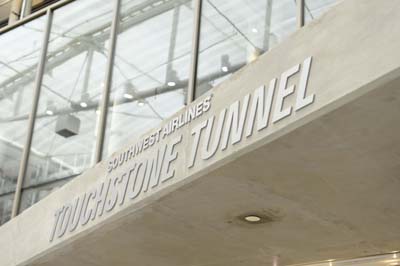 |
Southwest Airlines sponsors a tunnel that leads to a 45-yard playing field.
Photo by: Byron Small |
It’s “items and imagery,” as Brad Olecki, vice president of business development, likes to say.
Olecki primarily has been responsible for integrating the hall’s sponsors into the displays, either through branding or product placement, without it becoming too overwhelming. Founding partners AT&T, Chick-fil-A, Chick-fil-A Peach Bowl, Coca-Cola and Kia have their brands tastefully etched in brushed stainless steel around the second floor.
Coke sponsors a gallery on game-day traditions. Kia brought in a specially designed car with a drop-down TV and built-in grill for tailgating. Chick-fil-A, the hall’s presenting sponsor, has its name on multiple elements.
The two major spaces remaining without a sponsor are the 150-seat theater and the 45-yard field with a goalpost.
Stephenson and Olecki spearhead sales, with an assist from Fishbait Marketing’s Rick Jones.
The hall wouldn’t comment on the value of specific deals, but the 15 sponsorships sold so far went for a wide range, starting in the mid-to-high six figures for official partners to more than seven figures a year.
Founding partners have significant integration and product placement throughout. Other official partners had the opportunity to put their name on pieces of the building, like the Southwest Airlines Touchstone Tunnel, which leads from the lobby to the 45-yard playing field.
“The designers really let the partners have a voice as they were going through the process, which I think is unique,” Olecki said.
‘Our building is a big show’
The final flight of stairs ascends to the third floor, which is reserved for the actual hall of fame. The stone floors,wood walls and light hum of white noise send the message that this floor is different from the other two.
Rather than the busts that are so often associated with halls of fame, this one lists each class year-by-year.
Huge 6-foot-tall video displays show images, highlights and stats for the hall of famer selected, and the display swivels, enabling the visitor to see multiple angles as images of the player come to life.
Hall organizers thought the more contemporary displays fit the theme of the building more so than the traditional busts.
“This is the nicest room in the building,” Stephenson said as he proudly walked the hall of fame room.
The hall of fame is the room of reverence for the game’s greats, but it is, after all, just a segment of the overall project.
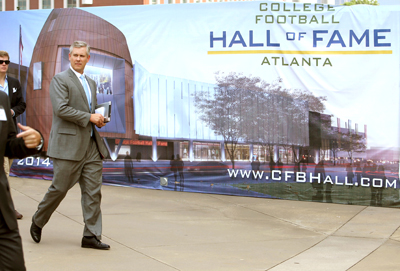 |
Hall of Fame CEO and President John Stephenson is eager to get down to business.
Photo by: AP Images |
Organizers named it the College Football Hall of Fame and Chick-fil-A Fan Experience for a reason. They want to send the message that there’s a lot more inside than the ring of honorees.
“I’m building a big stage for the hall, which is the NFF’s deal,” Stephenson said. “My job is to build this building and start this business.
“We’re not just in the hall of fame business, we’re in the attraction business. We’re in the entertainment business.
Our building is a big show. We’re going to sell you a ticket to see something you can’t see anywhere else. Yes, the hall of fame is in our building, but most of the building is an attraction on par with what is around us.”



